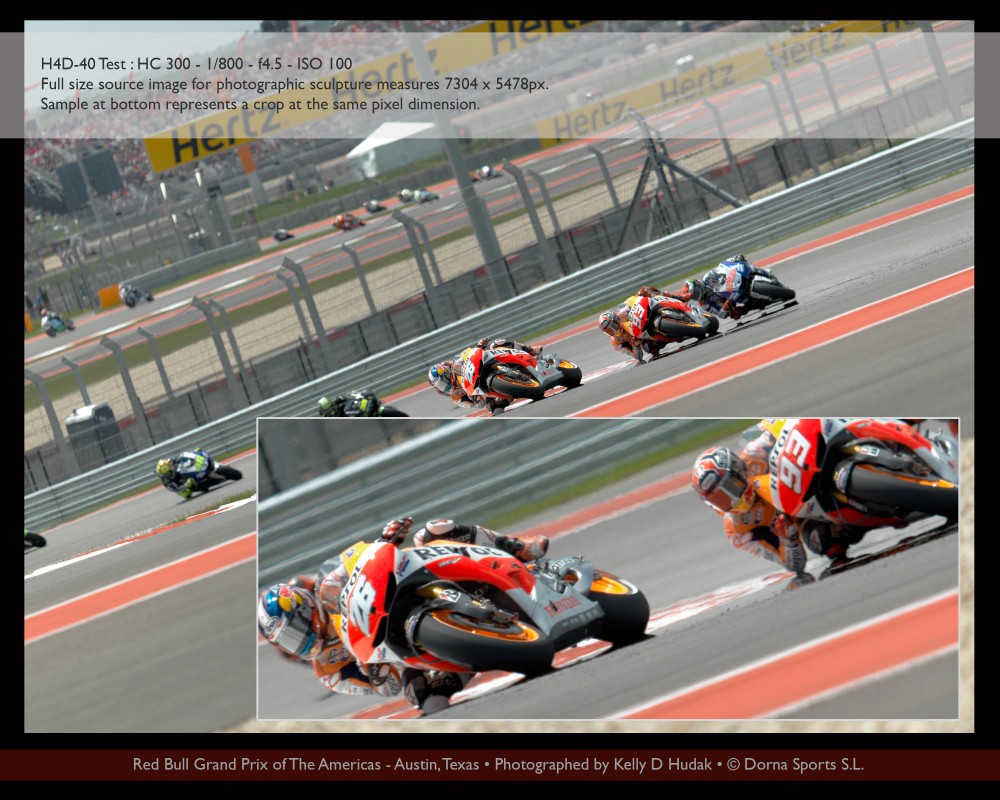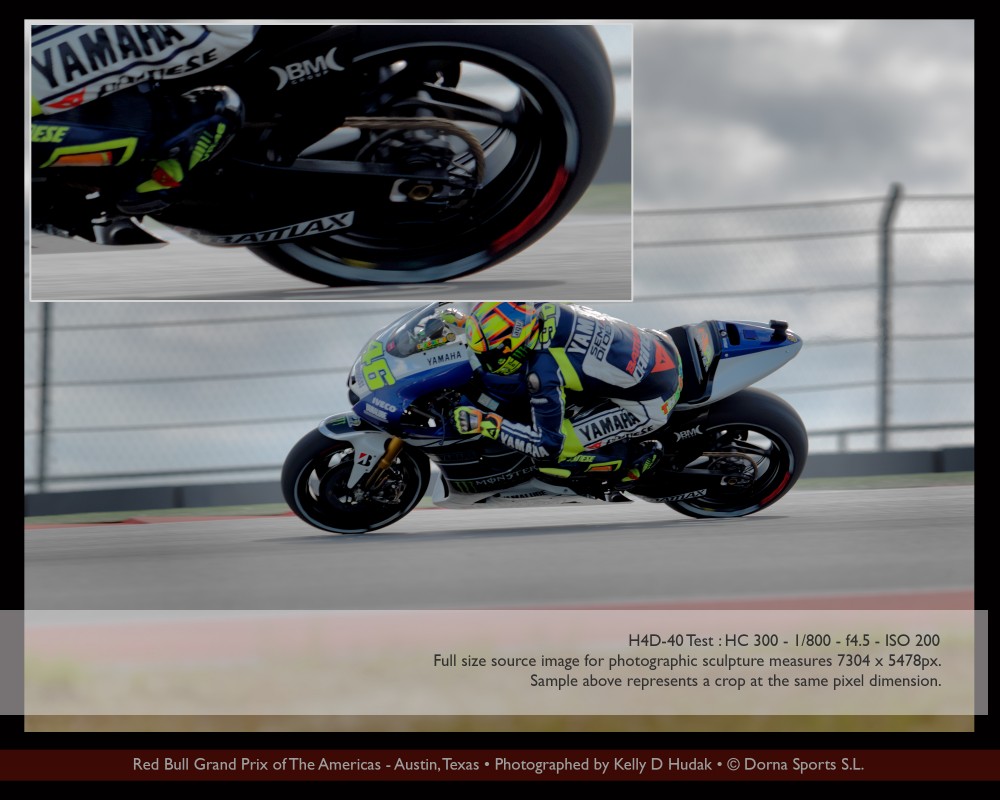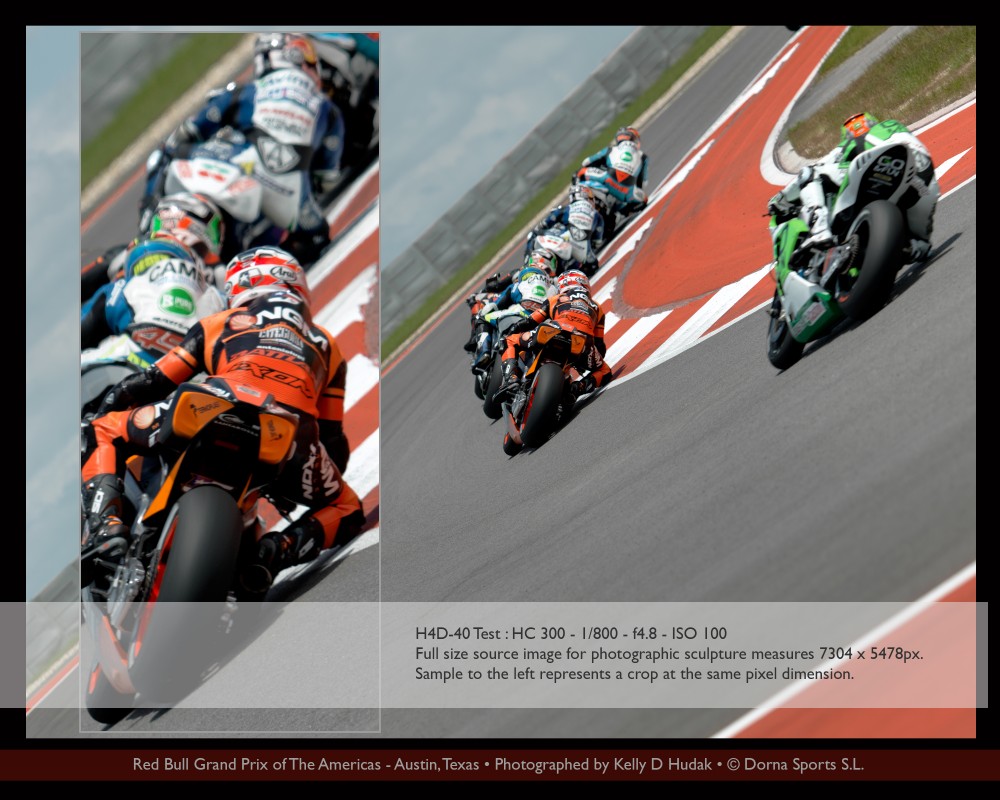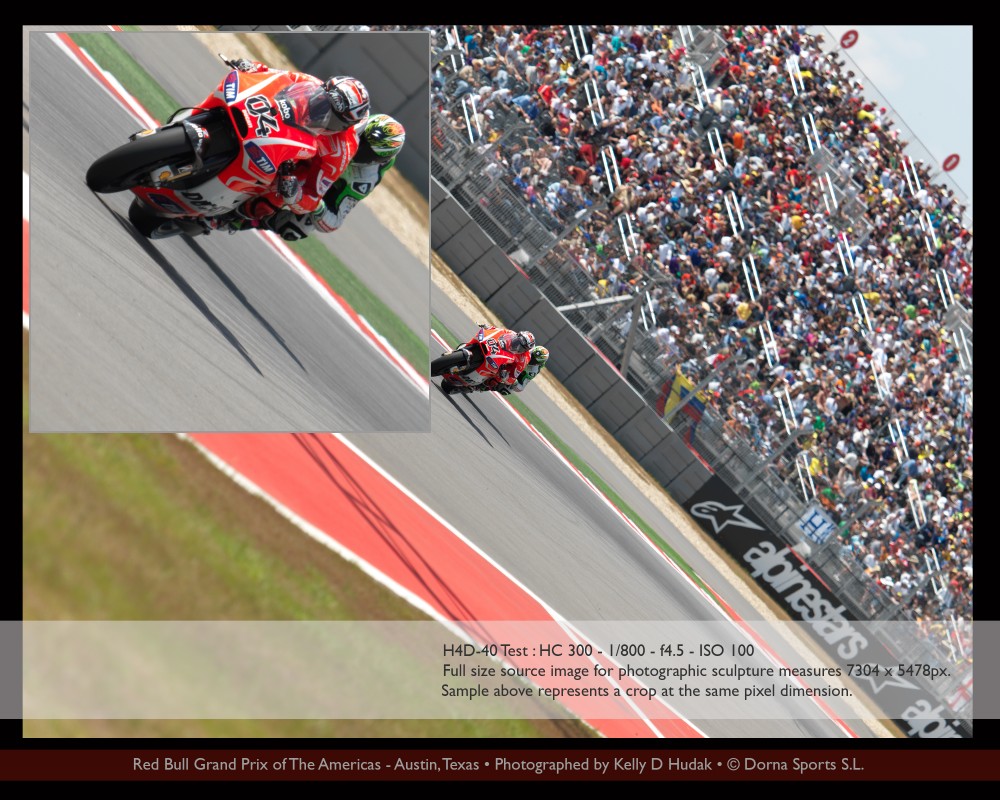
Kelly Hudak contacted our team this spring to make her first step into medium format. Here’s her wrap-up review of her experience with the Hasselblad H4D-40. Article written by Kelly Hudak. All images © Dorna Sports S.L.
It is through perseverance, determination and careful calculation that we come to see extraordinary results. Testing Hasselblad’s H4D-40 during the Red Bull Grand Prix of The Americas took my breath away. MotoGP makes up the premier class of riders developing prototype motorcycles around the world. These machines can exceed 200mph on a single straight! It is not the speed that has intrigued me though. Instead my research lies in the subtleties of the track design—sweeping curves, tight hairpins, and the occasional sudden drop in track elevation––where champions are challenged. I knew the Hasselblad would top out at 1/800s, a shutter speed that is slow in comparison to the modern DSLR. It would also pale in comparison to any DSLR’s capture; the H4D-40’s 1.1 frames per second may not be acceptable to some. Here I was still interested in the subtleties; top of the line sensor and camera software, unbelievable lens mechanics, and editing software that would make the most of the innovative technology. Capture Integration supported my pursuit and let me have a go at my first medium format test! Riding the edge I packed the H4D-40 and flew out to Texas with my partner, Bruce LaFollette, to meet with Dorna Sports S.L., international sports management, marketing and media company holding exclusive commercial and television rights for the FIM RoadRacing World Championship Grand Prix (MotoGPTM). We were well prepared to record the fine balance of focused concentration contained in a single decisive moment.

Lingering in my mind was John Parker’s article on the H4D-40 at hassebladaerial.com. He is one of the top air-to-air photographers and had used the Hasselblad camera, hand held on assignment, photographing the Breitling Aerobatic and Jet Teams. His stunning images and positive attitude towards medium format action photography inspired me to move forward and try it out for myself. While visiting with Dorna Sports in the past five years, Bruce and I have been exploring the idea of large scale race images, integrated into sculptural installation works—site specific in nature—further connecting a MotoGP host city to the race circuit itself. We needed the H4D-40 to interpret the depth of the scene our eyes were experiencing; full of light, reflections, shadow and texture.
Since 2008, I have been using DSLR’s at MotoGP events in preparation for public sculpture works and installation art. At 21 mega pixels, I found the Canon EOS-1Ds Mark III and 5D Mark II perfect for requirements in printing larger mock up concepts for future art spaces. I ended up collaging several DSLR captures into one and then printing the results on a translucent material that would be manipulated in such a way that the image took on an ethereal form. Somehow it wasn’t enough. I needed more than the 36 x 24mm sensor that my Canon provided to complete a monumental work. I dove into the Hasselblad sensor CCD at 33 x 44 carrying 40 mega pixels. I was not interested in how many images I could capture in one second, though auto-focus and exposure would prove to be an important consideration. I started to look over my exposure data from the last five years of captures at various races. I did use high shutter speeds for many compositions—surprisingly there were some great shots below 1/800s. I determined that I was within the limits to photograph MotoGP’s first visit to the Circuit of The Americas with the Hasselblad. I would later work out any anxieties I had over the auto-focus mechanism not being one of multi-point caliber! Practice is key. Larry Hansen, CEO of Hasselblad wished for the younger generations to see the value of medium format upon the H4D-40’s release in 2010—at this point he officially had my attention!

I held almost twice the sensor of my usual 35mm camera in my hands on the inside of turn 9. There were many other sites that Bruce and I had talked about and then tested but this is where I chose to be for the beginning of MotoGP’s second race of the season. It is the build up to turn 10 which is a blind exit that drops away. Turn 10 was too fast for the camera and what I was after so I stuck to the more conventional left-right-left build up at nearly 100mph. I was pleased to use the highly sophisticated Hasselblad telephoto lens for H cameras at 300mm f 4.5. It is suitable for “certain” sports and I took it to the test! I came to rely on the stability of the mechanism. On a minute level, I thought of the central lens shutter mechanism, made possible with magnetic fields and blades of carbon fiber laminate the thickness of a human hair. Thomas Johansson, the developer in charge of this design in Gothenburg, Sweden is akin to a motorcycle race engineer! He believes that he can do more in the future, as the market grows, with an agenda to see a faster lens shutter mechanism reaching 1/1000s. It is a delicate task because of the acceleration and the force being put on the four leaf-style shutter blades. Just this little bit of extra room, could mean so much in terms of photographing on the track, just as a rider and his team must find a little bit something more to turn a good race into a great one.

I felt a sense of ease in moving from the DSLR to the Hasselblad H4D-40. My thoughts as to the learning curve of which buttons do what and navigation in the menu is that every system is going to be different. I approached it with an open mind and tuned the camera to achieve the desired results. I preferred working in manual mode with spot metering on continuous. It allowed me to take in the entire scene, meter for sun and clouds and finally track a rider while recomposing my shot. I would like to see the Absolute Position Lock grow in terms of use from portraiture to action scenes covering a short distance; a small, tight turn for instance. I could almost see this modern yaw rate sensor being used in some of the slower corners––where there is not much movement in the camera position or the rider’s lateral movement. If the sensor measures angular velocity in an innovative way, I hope that at some point it can assist in calculating and adjusting focus while recomposing a moving shot within a short distance as described above. I have enjoyed using the multi-point auto-focus systems of the DSLR’s. The points have grown in number and are now displaced evenly in the photographers potential frame. What I like about Hasselblad’s True Focus, Absolute Position Lock, is that you may focus where it is important without a preselection of certain points. It seems like it makes for a faster, more accurate pace in studio work. Just as focus confirmation makes for working faster and more accurately out in the field with the motorcycles. I know there is more to be found in Hasselblad’s complex H camera mechanisms and am looking forward to the exploration.
Hasselblad’s Phocus software sealed the deal for me in image editing! First of all, I practically did not have to edit! Although it was fun to see just how much I could draw out of the MotoGP images. Usually I go to Bridge or Lightroom to do my editing, and then on to Photoshop. Getting to know Phocus was absolutely fantastic! Once I was used to the work-flow, I was happy to choose a favorite layout, view thumbnails and previews, browse my camera captures, adjust and export. The detail and color was extraordinary. I always go back to look at my images several times. In Phocus I could look at what Hasselblad calls the “ingredients” of your image and change it accordingly with no loss in image information. I could also save various adjustments, then load my saved ingredients to as many imported images as I felt necessary but take it all away just as fast and load another adjustment. The control is very intuitive and provided me with great comfort in image-making.

Some of the images I have captured from the Red Bull Grand Prix of The Americas will go to print so that my partner and I can determine just how far we can take the Hasselblad images into the realm of photographic and sculptural installation art. The artwork describes one-pointed focus where we allow ourselves to exist in the present moment. The worlds prototype motorcycle riders negotiate spaces where this free state of mind often exists in the face of immense intensity, where navigation becomes poetic and graceful as speed is demystified.
I am grateful for the support of Capture Integration and Dorna Sports S.L. for allowing me the time to see such a project evolve. Within our public installation preparation we strive to extract the careful balance in racing that lies between mental processing and technological advances. There is a space that exists within the two where one can let go. It is a meditative space and with the collaboration of architects and structural engineers we can magnify the extraordinary space of MotoGP in hopes of sharing its expression.
Hasselblad states the following, “Photographic tools may have changed, but one thing has not; Hasselblad’s almost fanatical dedication to image quality and our drive to innovate and invent the tools needed to achieve that quality.” I am coming up on ten years using DSLR technology. I hope that the next decade of my work will include exploring the world of medium format with great dedication to my projects. It was Victor Hasselblad’s desire to capture the flight of birds with his camera development, why not an artist and motorcycles.